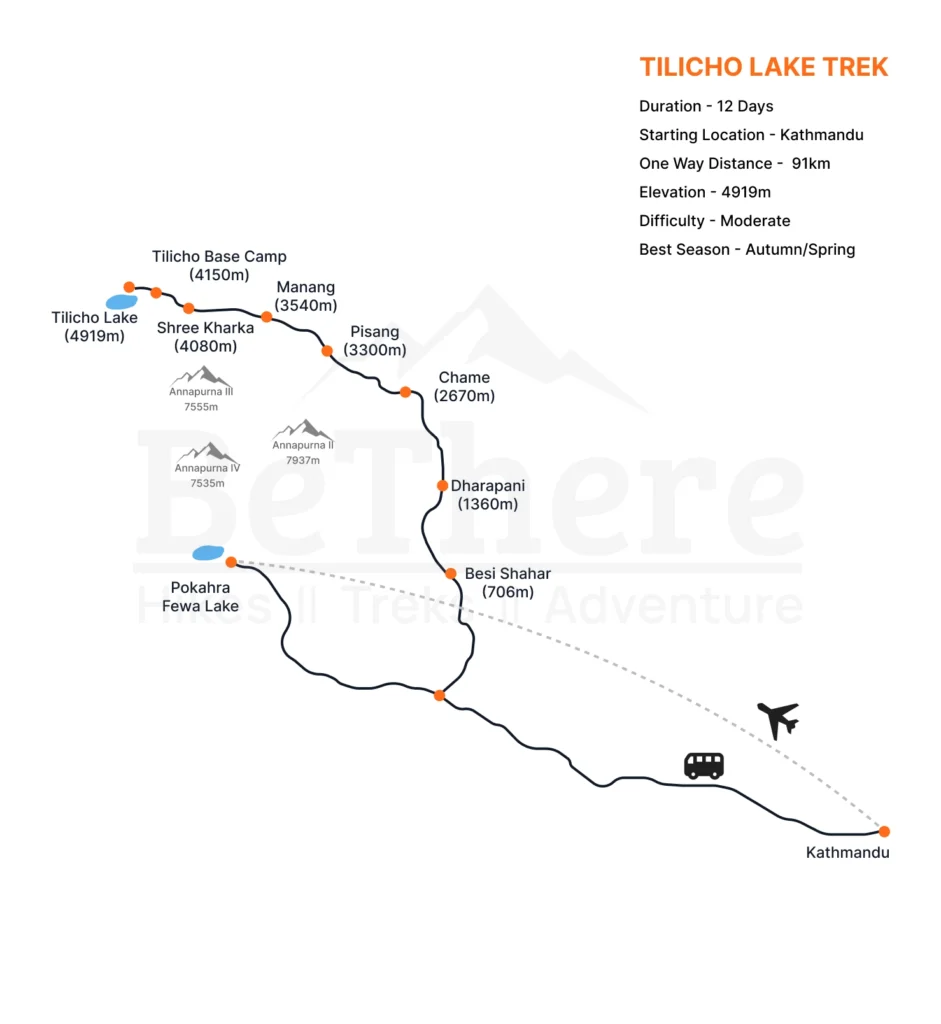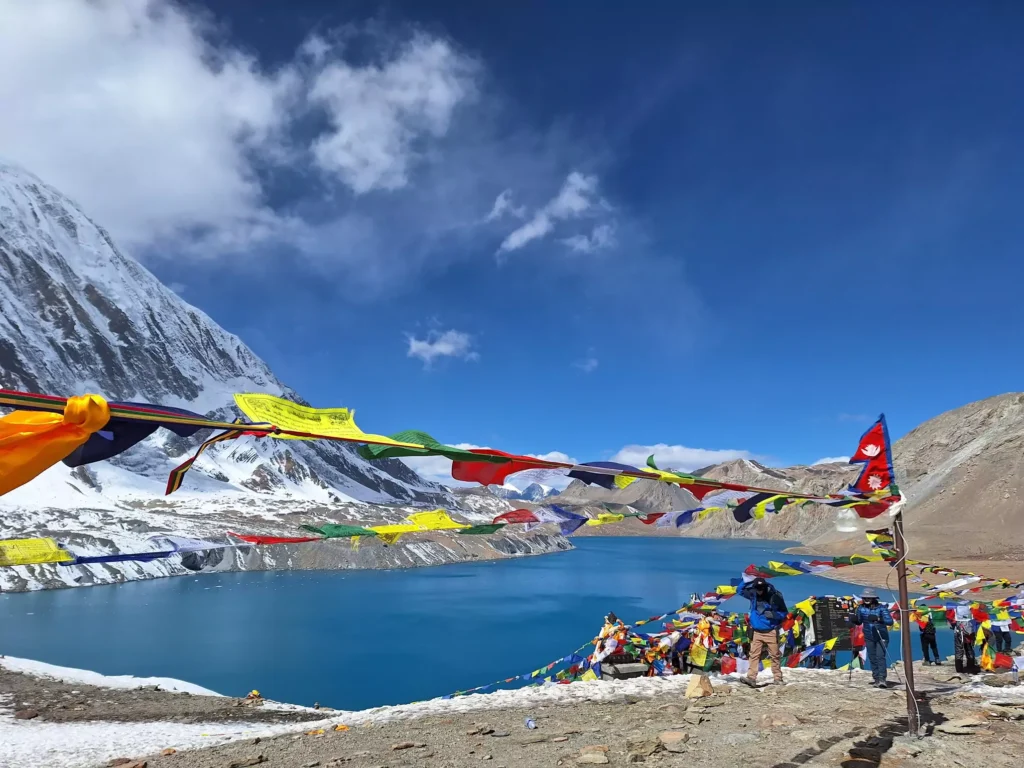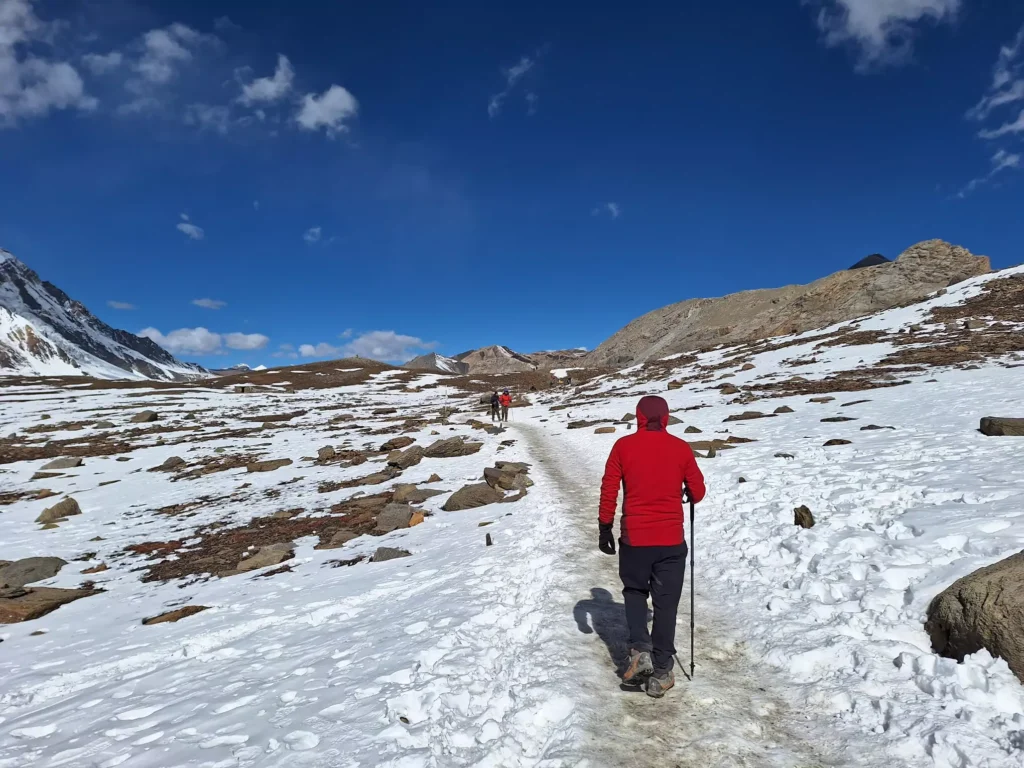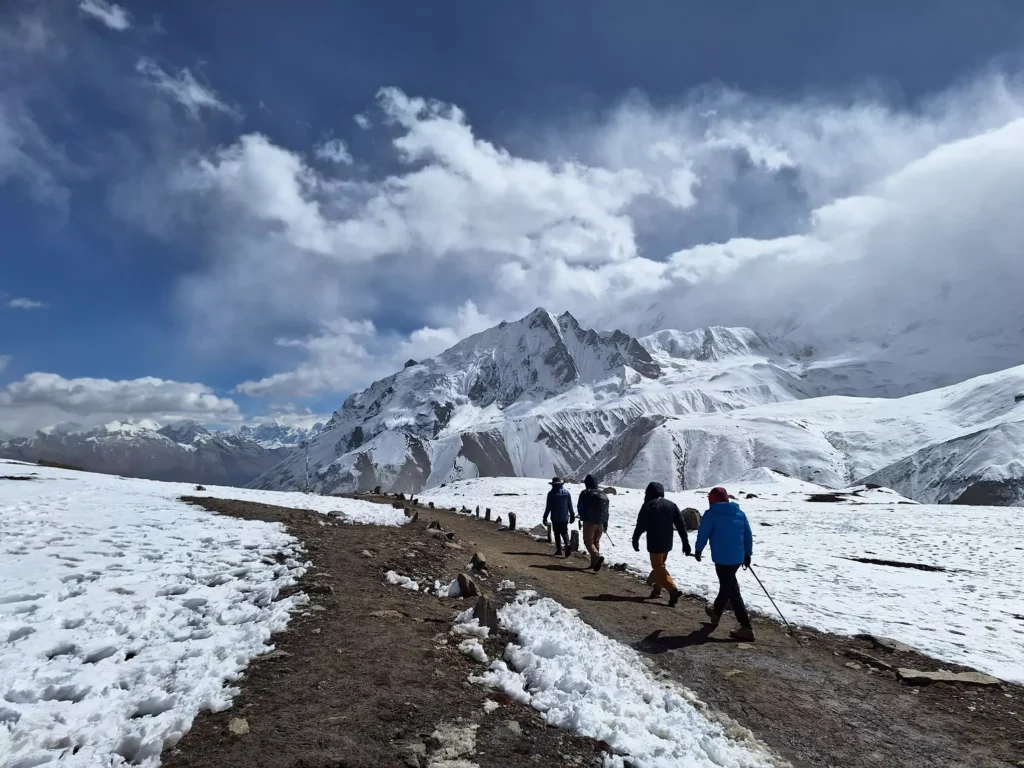Duration
11 Days
Max. Altitude
4919m
Difficulty Level
Moderate
One Way Distance
91Km
Start/End Point
Kathmandu
Best Season
Autumn/Spring
Duration
11 Days
Max. Altitude
4919m
Difficulty Level
Moderate
One Way Distance
91Km
Start/End Point
Kathmandu
Best Season
Autumn/Spring
Overview
The Tilicho Lake Trek is an amazing Himalayan journey that takes you deep into the beautiful Annapurna region, ending at Tilicho Lake, one of the highest lakes in the world at 4,919 meters. This trek combines stunning mountain views, high-altitude lakes, and authentic local culture. Starting from the lively city of Kathmandu, you will travel through beautiful valleys, terraced fields, past waterfalls like Khangsar Khola, and traditional villages surrounded by towering peaks.
Along the way, you’ll see breathtaking views of Annapurna II(7,937m), Pisang Peak(6091m), Gangapurna(7,455m), and the high mountains around the Manang Valley. The trek includes some tough climbs and rugged paths but rewards you with peaceful alpine meadows, glaciers, and the stunning Tilicho Lake itself, sitting beneath snowy mountains. You’ll also experience the unique culture of the Gurung and Manangi people in villages like Pisang and Manang, and pass through quiet settlements like Shree Kharka. This trek is perfect for travelers who want a less crowded route with incredible natural beauty and rich culture.
The 11-day itinerary below shows what you can expect on this adventure. Each day offers new sights and memorable experiences as you explore one of Nepal’s most beautiful mountain regions.
Highlights of Tilicho Lake Trek
- Stand before Tilicho Lake (4,919m), one of the world's highest lakes, framed by Tilicho Peak (7,134m) and Nilgiri North (7,061m)
- Enjoy panoramic views of Annapurna II (7,937m), Pisang Peak (6,091m), and Gangapurna (7,455m)
- Trek through diverse landscapes: pink rhododendron forests near Chame, alpine meadows of Yak Kharka
- Explore traditional villages like Pisang, known for its medieval style architecture, and Manang (3,540m), home to the ancient Braga Monastery
- Discover hidden lakes, including Ice Lake (4,620m) near Manang
- Stay in cozy teahouses like Tilicho Base Camp Lodge, where you'll taste local Tibetan bread and sea buckthorn juice
- Witness the Gangapurna Glacier's blue icefalls and the dramatic Khangsar Landslide Zone
Best Season For Tilicho Lake Trek
The best time to undertake the Tilicho Lake Trek is during the pre-monsoon (spring) and post-monsoon (autumn) seasons.
Autumn (September to November) is the most popular trekking season. After the monsoon rains, the air is clear and fresh, providing stunning views of the Annapurna range and surrounding peaks. Daytime temperatures are comfortable, though nights can be quite cold, especially at higher altitudes. This is when the famous landslide section between Shree Kharka and the lake is most stable.
Spring (March to May) offers mild weather and beautiful rhododendron forests bursting with colorful blooms. The skies are usually clear, making it an excellent time for nature lovers and photographers to enjoy spectacular mountain scenery. By April, temperatures reach 15°C in the valleys while Tilicho Lake begins shedding its winter ice, revealing stunning turquoise waters.
Both seasons provide ideal conditions for trekking to Tilicho Lake, with stable weather and breathtaking landscapes.
Trek Itinerary & Route Map
Day 01Arrival in Kathmandu (1400m/4593ft)
Welcome to Nepal! After landing at Tribhuvan International Airport, our representative will greet you and transfer you to your hotel in the heart of Kathmandu. After settling in and freshening up, you’ll attend a comprehensive trek orientation where the team will walk you through the route, essential gear, and trekking guidelines. If time permits, feel free to step out and take in some of the city’s lively atmosphere, local shops, or nearby temples. Overnight at your hotel in Kathmandu.
Day 02Drive from Kathmandu to Besisahar (760m / 2493ft)
Begin your journey early in the morning with a scenic drive from Kathmandu to Besisahar. The 6-hour drive winds through lush hills, rural settlements, and riverside roads. Along the way, you can catch glimpses of distant Himalayan peaks and enjoy lunch at a local stop. Arrive in Besisahar by afternoon and rest for the night at a comfortable lodge. This town serves as the gateway to many treks in the Annapurna region.
Day 03Drive from Besisahar to Lower Pisang (3200m / 10,498ft)
Today’s drive climbs higher into the Himalayas, passing through rocky gorges, forests, and small villages. The 7-hour journey includes thrilling jeep tracks and amazing scenery. As you approach Lower Pisang, you’ll be greeted by majestic views of Annapurna II and Pisang Peak. The alpine village of Lower Pisang offers a great place to rest and acclimatize to the elevation. Overnight in Lower Pisang.
Day 04Trek from Lower Pisang to Manang (3500m / 11,482ft)
Embark on your first full day of trekking with a 14-kilometer route to Manang. The trail ascends gradually and passes through the picturesque village of Ghyaru, offering panoramic views of Annapurna II and IV. You’ll walk past prayer flags, mani walls, and traditional stone houses. Arrive in Manang by late afternoon, a vibrant village filled with bakeries, tea houses, and trekkers. Overnight in Manang.
Day 05Trek from Manang to Ice Lake (4620m / 15,157ft); Return to Manang
Take a full day to acclimate with a scenic side trip to Ice Lake. The hike begins with a gentle ascent and passes through yak pastures, alpine meadows, and forested trails. You’ll climb nearly 900 meters and reach Ice Lake, a glacial alpine lake nestled beneath snow-covered peaks. After enjoying the spectacular views and fresh air, descend back to Manang for a restful night. Overnight in Manang.
Day 06Trek from Manang to Tilicho Base Camp (4150m / 13,615ft)
Begin your trek towards Tilicho Base Camp, one of the most remote and breathtaking camps in the region. The 7-hour route passes through Shree Kharka, a small settlement with incredible views. You’ll cross landslide-prone areas and trek along rugged terrain before reaching the high alpine base camp. Spend the evening resting and preparing for the highlight of your journey. Overnight at Tilicho Base Camp.
Day 07Trek to Tilicho Lake (4919m / 16,138ft) and Return to Shree Kharka (4050m / 13,287ft)
Start early for the challenging ascent to Tilicho Lake, the highest lake in the world. The 3–4 hour climb offers awe-inspiring views of ice-covered peaks and the barren high-altitude landscape. Spend time absorbing the lake’s serenity before retracing your steps back down to Base Camp and continuing to Shree Kharka for the night. Total trekking time is about 9 hours. Overnight in Shree Kharka.
Day 08Trek from Shree Kharka to Manang (3500m / 11,482ft)
Descend gradually along alpine trails back to Manang, enjoying changing views of the valley and surrounding peaks. Back in this vibrant mountain village, you can relax at local bakeries, visit the monastery or museum, and take in views of Gangapurna Glacier and Annapurna III. Take time to rest, recharge, and enjoy the peaceful high-altitude atmosphere. Overnight in Manang.
Day 09Drive from Manang to Besisahar (760m / 2493ft)
Bid farewell to the high mountains as you take a long drive from Manang back to Besisahar. The drive takes approximately 7 hours along rugged mountain roads and through terraced hillsides. Reflect on your journey as you descend into lower altitudes. Besisahar provides a peaceful setting to relax and recover from your trek. Take some time to explore the local market and experience everyday life in this charming town. Overnight in Besisahar.
Day 10Drive from Besisahar to Kathmandu (1400m / 4593ft)
Enjoy a 5-6 hour drive to Kathmandu. Once you arrive, settle into your hotel and explore or relax before the departure. You can roam around palaces of valley, take a relaxing massage, or explore the bustling markets and cafés. Kathmandu provides a refreshing contrast to the remote trails you’ve conquered. Overnight in Kathmandu.
Day 11Final Departure from Nepal

Includes/Excludes for Tilicho Trek
- Airport pick-up and drop-off in Kathmandu
- 2 nights of hotel accommodation in Kathmandu with breakfast
- All ground transportation (Kathmandu–Besisahar–Pisang–Manang–Besisahar–Kathmandu)
- All necessary permits (Annapurna Conservation Area Permit & TIMS card)
- 6 nights' accommodation in standard lodges/guesthouses during the trek
- All meals during the trek (breakfast, lunch, and dinner)
- English-speaking licensed trekking guide($30 per day)
- Porter service (1 porter for every 2 trekkers)
- Staff insurance, equipment, and salary
- First aid kit and emergency oxygen carried by the guide
- Trekking orientation session in Kathmandu
- Farewell dinner in Kathmandu after the trek
- International flights to and from Nepal
- Nepal visa fees
- Meals in Kathmandu and Pokhara (except breakfast)
- Extra nights in case of early return, delays, or bad weather
- Personal expenses (e.g., Wi-Fi, laundry, hot showers, charging, snacks, bottled water)
- Travel, medical, and evacuation insurance
- Tips for your guide and porter
- Any services not mentioned under “Included”
Note
Please note that due to ongoing road construction along the Prithvi Highway, the drive from Kathmandu to Pokhara has become more time-consuming and dusty than usual. While this journey typically takes around 6–7 hours, current conditions may extend it to 8–9 hours due to traffic congestion and air pollution. We kindly ask for your patience and understanding during this transitional period.
Gears & Equipment
Item
Quantity
1 set of base/thermal Layer and 1 mid-layer
1
1 Set outer layer
1
1 waterproof jacket and 1 waterproof trousers, or raincoat/punchoo instead.
1
1 pair of lightweight trekking trousers or zip-off pants.
1
2 trekking t-shirts/shirts-merino is ideal
2
Four Season Sleeping bag.
1
Four Season Down Jacket.
1
1 pair liner gloves
1
1 warm wool hat
1
1 sunhat or similar
1
Sleeping bag liner
–
Travel towel
–
Sunscreen
–
Moisturizer
–
Lip Balm
–
Toilet Paper
–
1 rucksack/duffle bag for the porters to carry with your overnight kit
1
1-day pack (approx. 30ltr) with a waterproof cover
1
2 x 1ltr water bottles or CamelBak
2
1 x head torch
1
Water purification tablets
–
1 pair trekking boots (must be worn in)
1
Sandals or hut shoes
–
3 pairs thick walking socks / 3 pairs lighter walking socks
3
Running Shoes or sneakers.
1
Power bank
–
Thermal Flask
–
Adaptors: Nepal uses Type D, C and M
–
Accommodation and Food
During the Tilicho Lake Trek, you’ll spend 6 nights in locally run lodges and teahouses along the trail. These lodges offer clean, cozy rooms with comfortable beds and warm blankets, some with attached bathrooms for added convenience. They also have shared dining areas where trekkers can enjoy a variety of freshly cooked meals, including both local Nepali dishes like dal bhat and international options such as noodles, pasta, and soups.
In Kathmandu, Pokhara, and Beshisahar, you will stay in well-equipped hotels for 4 nights with breakfast included, offering modern amenities to relax before and after your trek.
Food Provided: Breakfast, lunch, and dinner during the trek; breakfast in Kathmandu and Pokhara. Meals are served fresh, and you can choose from the available menu at each lodge.
Route Safety and Emergency Plans
Your safety is our top priority throughout the Tilicho Lake Trek. The route includes high-altitude trails and rugged terrain, so proper precautions and emergency protocols are in place at every stage.
- Our experienced guides are professionally trained in high-altitude trekking and first aid, ensuring that you’re in safe hands at all times.
- A well-stocked first aid kit is carried during the trek to manage minor injuries or altitude-related symptoms.
- A GPS tracking device is used for navigation and real-time location updates, especially in remote and landslide-prone areas.
- In case of severe altitude sickness or medical emergencies, helicopter evacuation is always part of the plan. Costs for evacuation typically range between $2,000 to $2,500
FAQs
1. How long is the Tilicho Lake Trek?
The Annapurna Circuit Trek is considered moderately to highly challenging. It involves several days of walking, steep climbs, and high altitudes. With good preparation and acclimatization, most trekkers with average fitness can complete it.
2. How difficult is the Tilicho Lake Trek?
Spring (March to May) and autumn (September to November) are the best seasons. These months offer clear skies, pleasant weather, and incredible mountain views. Monsoon and winter are generally avoided due to rain, snow, and trail conditions.
3. What’s the best time to do the Tilicho Lake Trek?
Yes, altitude sickness is a real risk, especially when crossing Thorong La Pass. The trek includes built-in acclimatization days, and it’s important to ascend gradually, drink lots of fluids, and listen to your body.
4. Do I need a permit for the Tilicho Lake Trek?
As of 2025, hiring a licensed guide for the Annapurna Circuit Trek is mandatory for trekkers to comply with Nepal’s trekking regulations and ensure safety. While porters are not required, they are highly recommended to carry your gear and make the trek more comfortable and enjoyable.
5. Is altitude sickness a big concern on the Tilicho Lake Trek?
You’ll stay in teahouses or simple guesthouses run by locals. They provide clean rooms, warm meals, and a place to rest. Most rooms are twin-sharing with shared bathrooms, though private options are available in some villages.
6. What kind of accommodation can I expect on the Tilicho Lake trek?
Food options during the trek include traditional Nepali meals like dal bhat, as well as pasta, fried rice, soups, eggs, and pancakes. Meals are made fresh at the lodges and help keep your energy up during the trek.
7. What essentials should I pack for the Tilicho Lake Trek?
You should bring sturdy trekking boots, layered clothing for changing weather, waterproof jackets, and a warm sleeping bag. Don’t forget sun protection like sunglasses and sunscreen. A detailed gear checklist is usually provided, which is very helpful, especially for first-time trekkers.
8. Can I get food and water along the Tilicho Lake Trek trail?
Yes, teahouses serve Nepali staples like dal bhat, soups, and noodles. Bottled water is available but pricey, so many trekkers prefer water purification methods. It’s a good idea to carry snacks and water purification tablets just in case.
9. Will I have cell phone or internet access during the Tilicho Lake Trek?
Cell service is limited and mostly unreliable at higher altitudes near Tilicho Lake. Some lodges offer Wi-Fi, but it can be slow and expensive. This makes it a perfect chance to disconnect from the digital world and enjoy nature’s quiet.
10. Is the Tilicho Lake Trek crowded?
No, the Tilicho Lake Trek is much less crowded than popular routes like Annapurna Base Camp or Everest Base Camp. You’ll enjoy peaceful trails and a more authentic Himalayan experience. The Tilicho Lake trek is perfect for those looking to escape the crowds and explore nature off the popular path.
Need help with your trek?
Reach out to our travel experts
All Inclusive Pricing
USD $1300 $1000 / Minimum 2 Pax
Plan Your Hike

Nepal🇳🇵
What Trekkers are Saying About Us
Upper Mustang was unlike anywhere else I’ve been. The landscape is surreal. Suman Limbu’s deep knowledge of the area and stories about local culture made the trek unforgettable. I really felt connected to the place.

Megan Walker
Traveler from USA
Trekking the Annapurna Circuit was unforgettable. The landscape changes kept me in awe every day. Our guide, Aryan Lama, was fantastic; always patient and encouraging, especially on the steep parts. His knowledge about the region made the trek richer.

Claire Adams
Traveler from Australia
Langtang was peaceful with breathtaking glacier views. Aryan Lama’s easy-going nature made the trek enjoyable even on the harder days. It felt less like a guided tour and more like trekking with a knowledgeable friend.

Daryl Wong
Traveler from Singapore
Tilicho Lake’s turquoise water and surrounding peaks were absolutely stunning. John Bipra’s encouragement helped me push through the toughest parts. The whole trek was perfectly planned, which made the experience unforgettable.

Mateus Costa
Traveler from Brazil
Everest Base Camp is a dream for any trekker. The trek was tough, but our guide John Bipra made it manageable with his calm and experienced leadership. I never felt alone or overwhelmed, and that made all the difference.

Élodie Martin
Traveler from France
Dhap Dam’s calm waters and green surroundings made for an amazing day hike. I really appreciated how BeThere handled all the details. It felt like they had thought of everything so the day went perfectly.

Sophie Chen
Traveler from Canada
Need help choosing a trail?
Connect with a local and plan your perfect trek.


